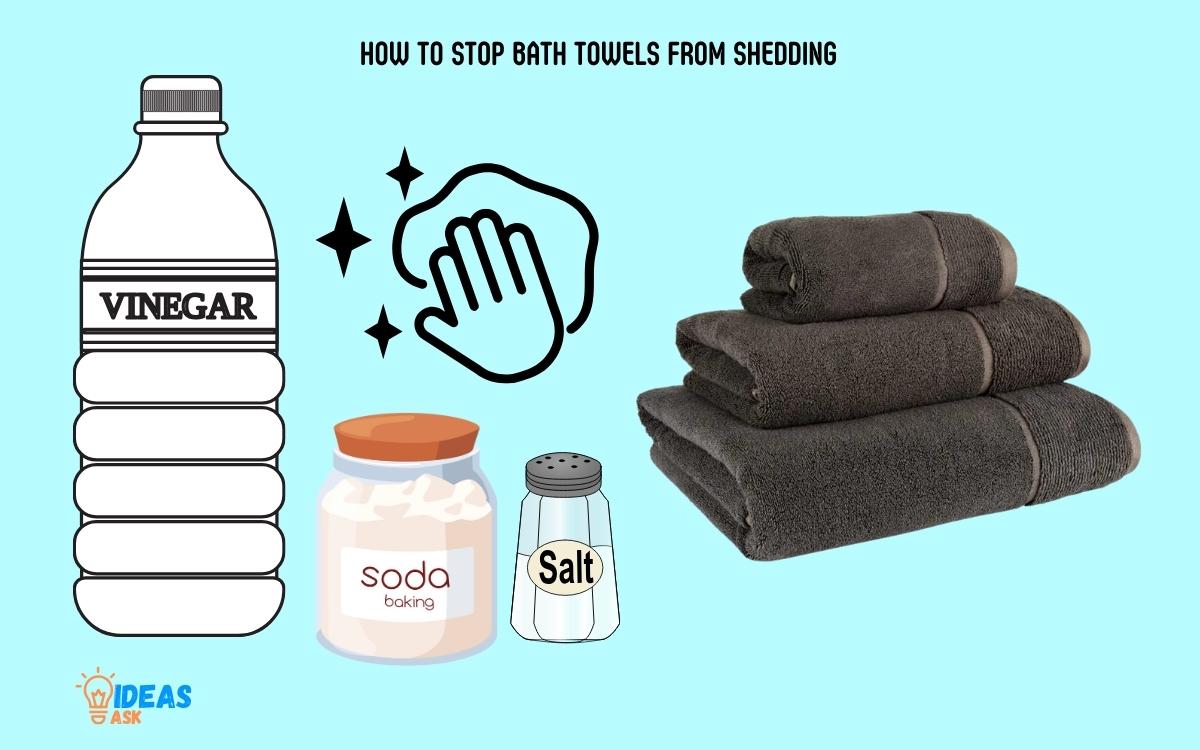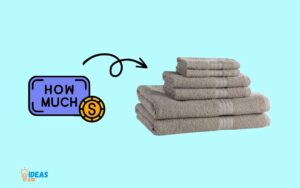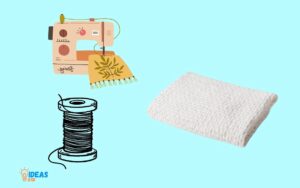How to Stop Bath Towels from Shedding? 3 Easy Steps!
To stop bath towels from shedding, begin by washing new towels separately in cold water and a cup of distilled white vinegar.
This process helps in setting the towels’ colors and removing excess lint. Avoid using fabric softeners as they can leave a residue that increases shedding.
Lastly, dry towels thoroughly but with low heat to maintain the towel’s fiber integrity.
When you purchase new bath towels, they often shed lint because of the excess fibers left from the manufacturing process.
Drying towels on low heat prevents overheating, which can damage the fibers and cause more shedding. To reduce shedding from your bath towels, it is vital to care for them properly right from the start.
Beginning with a vinegar wash, avoiding fabric softeners, and ensuring to dry on a low heat setting can all contribute to maintaining the integrity of the towel’s fibers and therefore reduce shedding.
Regularly shaking out your towels can also help remove loose fibers before they shed.

Key Takeaway
Step-by-Step Guide to Stop Bath Towels from Shedding
Step 1: Buy Quality Towels
When purchasing new bath towels, opt for ones made from high-quality cotton, bamboo, or microfiber fabrics. These tend to be more durable and less prone to shedding than cheaper, lower-quality towels.
Step 2: Wash Towels Properly
- Wash in Cold Water: Wash towels separately in cold water to avoid excessive agitation. Hot water can be rough on towels and cause more shedding.
- Avoid Fabric Softener: Skip the fabric softener, as it can leave a coating on towels that causes fibers to detach more easily. The chemicals in liquid softeners break down cotton fibers.
- Wash Towels Separately: Wash towels separately from other laundry to prevent lint from clinging to them. Towels can act like lint magnets.
Step 3: Dry Towels Correctly
- Shake Out Towels: Before drying towels, give them a good shake to remove any loose fibers. This prevents the fibers from attaching to the towels.
- Line Dry When Possible: Line drying towels in the sun whenever possible minimizes fiber loss from the heat and tumbling of machine drying.
- Dry on Low Heat: When machine drying, use the lowest heat setting to be gentle on the towels. High heat can damage fibers.
Following these basic guidelines for washing and drying should help stop those annoying towel fibers from ending up all over!
Understanding The Causes Of Towel Shedding
Discover the underlying causes of towel shedding and learn effective techniques to prevent it. Say goodbye to lint on your bath towels with these practical tips and keep your towels looking fresh and lint-free.
Bath towels shedding their fibers can be frustrating and lead to a less pleasant drying experience. Fortunately, by understanding the causes of towel shedding, you can take appropriate measures to prevent it.
We will explore common reasons for bath towels shedding, factors that affect shedding, and the impact of towel quality on shedding.
Common Reasons For Bath Towels Shedding:
- Poor fabric quality: Towels made from low-quality materials or loosely woven fibers are more likely to shed.
- Excessive washing: Frequent washing with harsh detergents or fabric softeners can weaken the towel fibers and cause shedding.
- Over-drying: High heat settings on dryers can damage the towel fibers, leading to shedding.
- Friction and abrasion: Rough handling, rubbing against rough surfaces, or using towels with Velcro can cause fibers to loosen and shed.
- Age and wear: Older towels that have endured years of use might shed more due to natural wear and tear.
Factors Affecting Towel Shedding:
- Fiber type: Towels made from certain fibers, such as cotton or bamboo, are more prone to shedding than others like microfiber.
- Weave density: Towels with a looser weave are more likely to shed as the fibers are not securely held together.
- Density of fibers: Towels with a higher density of fibers have a lower propensity to shed.
- Fabric finish: Towels with smoother finishes are less likely to shed, while those with rough or textured finishes may shed more.
Impact Of Towel Quality On Shedding:
- Higher thread count: Towels with higher thread counts generally shed less as the fibers are tightly woven, minimizing shedding.
- Absorbency: Higher quality towels that are more absorbent often shed less because they are made with better materials and construction techniques.
- Durability: Well-made towels with reinforced edges and strong fibers are less likely to shed over time.
Remember, preventing towel shedding begins with selecting high-quality towels, giving them proper care, and minimizing factors that contribute to shedding.
By understanding the causes and taking necessary precautions, you can enjoy fluffy, shed-free bath towels for a longer time.
Care And Maintenance For Shed-Free Towels
Learn how to prevent shedding in your bath towels with these care and maintenance tips. Keep your towels looking great and shed-free for a longer period of time.
Bath towels are an essential part of our daily routine, providing comfort and absorbency after a relaxing shower or bath. However, dealing with constant shedding can be frustrating.
The good news is that with proper care and maintenance, you can prevent towels from shedding and enjoy their softness for years to come.
Here are some tips to help you keep your towels shed-free:
Washing Tips To Prevent Shedding
- Wash new towels before use: Before you start using your brand new towels, it’s important to give them a thorough wash. This helps to remove any loose fibers that might be present.
- Use the right detergent: Choose a mild detergent that is free from harsh chemicals. Harsh detergents can weaken the fibers of your towels, leading to shedding.
- Wash towels separately: To avoid excessive shedding, always wash your towels separately from other clothing items. This helps to prevent abrasion and minimizes the chances of lint transferring to your towels.
- Wash in cold water: Hot water can cause the fibers of your towels to weaken, resulting in shedding. Opt for cold water instead, which is gentler on the fabric.
- Avoid overloading the washer: Overloading the washer can put stress on the towels and increase the chances of shedding. Make sure there is enough space for the towels to move freely during the wash cycle.
- Skip the fabric softener: As tempting as it may be to add fabric softener, it is best to avoid it when washing towels. Fabric softeners can leave a residue on the fibers, leading to shedding.
Proper Drying Techniques
- Shake out the towels before drying: Before you hang your towels to dry, give them a good shake to remove any loose fibers or lint.
- Air dry or tumble dry low: It is recommended to air dry your towels whenever possible. This reduces the risk of shedding and helps to preserve their quality. If you prefer to use a dryer, choose a low heat setting to avoid excessive heat damage.
- Avoid over-drying: Over-drying your towels can make them stiff and increase the chances of shedding. Remove the towels from the dryer while they are still slightly damp to retain their softness.
Appropriate Towel Storage Methods
- Fold towels neatly: When storing your towels, make sure to fold them neatly to minimize stress on the fibers. This helps to maintain their integrity and reduce shedding.
- Use breathable storage containers: Avoid storing towels in plastic bags or airtight containers. Opt for breathable storage containers or shelves instead to allow proper airflow, which prevents moisture buildup and potential shedding.
- Choose a cool and dry storage area: Moisture and high temperatures can weaken towel fibers, leading to shedding. Store your towels in a cool, dry place away from direct sunlight to maintain their quality.
By following these care and maintenance tips, you can prolong the life of your towels and prevent shedding. Remember, a little extra care goes a long way in ensuring that your towels remain soft, fluffy, and shed-free for many years of enjoyable use.
Dealing With Shedding Towels
Tired of dealing with shedding towels? Learn how to stop bath towels from shedding with these simple tips. Keep your bathroom clean and enjoy lint-free drying.
Strategies To Reduce Shedding:
- Wash towels before use: Wash newly purchased bath towels before using them for the first time. This helps remove any loose fibers and reduces shedding.
- Use a gentle cycle: When washing towels, opt for a gentle cycle on your washing machine. This reduces the wear and tear on the fabric, minimizing shedding.
- Avoid fabric softeners: While fabric softeners make towels feel softer, they can also cause fibers to become loose and shed more. Instead, try using vinegar as a natural alternative to soften your towels.
- Ditch the dryer sheets: Similar to fabric softeners, dryer sheets can leave a residue on towels that leads to shedding. Skip the dryer sheets altogether or use dryer balls to reduce static without any shedding side effects.
- Shake out towels before drying: Before placing your towels in the dryer, give them a good shake to remove any loose fibers. This can help prevent shedding during the drying process.
- Dry on a low heat setting: High heat can weaken the fibers of your towels and contribute to shedding. To reduce shedding, dry your towels on a low heat setting or opt for air drying if possible.
Troubleshooting Common Shedding Issues:
- Excessive lint in the dryer: If you notice an excessive amount of lint in your dryer trap after drying towels, clean the trap thoroughly. Clogged lint traps can prevent proper airflow, causing the towels to shed more.
- Overloading the washing machine: Overloading your washing machine can put stress on the towels, resulting in shedding. Make sure not to cram too many towels into a single load and give them enough space to move freely during the wash cycle.
- Rough surfaces or hooks: Towels rubbing against rough surfaces or getting caught on hooks can cause fibers to become loose and shed. Be mindful of where you hang and store your towels to minimize friction and potential shedding.
Reviving Old Towels Experiencing Shedding:
- Use a lint roller: If your towels are shedding after multiple uses and washes, try using a lint roller to remove loose fibers. Roll the lint roller over the towel surface to pick up any stray lint or fibers.
- Trim loose threads: Inspect your towels for any loose threads and carefully trim them with a pair of scissors. Removing loose threads can help prevent further shedding.
- Give them a vinegar soak: Fill a bathtub or large basin with warm water and add a cup of white vinegar. Soak your towels in this mixture for about 30 minutes before giving them a thorough rinse. This vinegar soak can help revive the fibers and reduce shedding.
Remember, following these strategies, troubleshooting common issues, and reviving old towels can help you minimize shedding and prolong the lifespan of your bath towels. Keep your towels fluffy and shed-free for a delightful post-bath experience.
Alternative Solutions For Towel Shedding
Discover effective alternative solutions for preventing towel shedding in your bathroom. Say goodbye to those annoying fibers with these helpful tips and tricks. Keep your bath towels shedding-free and enjoy a luxurious and comfortable bathing experience.
Exploring Anti-Shedding Additives For Towels:
- Silicone-based treatments: Adding silicone-based additives to towel fibers can help reduce shedding. Silicone forms a protective coating on the fibers, preventing them from breaking and shedding. This treatment also makes towels softer and more absorbent.
- Natural fiber reinforcements: Incorporating natural fibers like bamboo or hemp into the towel’s composition can strengthen the fibers and reduce shedding. These fibers have inherent properties that make them less prone to shedding and ensure the durability of the towel.
- Microfiber blends: Mixing microfiber with the towel’s main fiber can minimize shedding. Microfiber has tightly woven fibers that are less likely to shed, providing a smooth and durable texture. This blend also enhances the towel’s absorbency.
Innovative Towel Technologies To Prevent Shedding:
- Hydrophobic coatings: Some towels now come with hydrophobic coatings, which repel water and prevent shedding. These coatings create a barrier that stops moisture from getting trapped within the fibers, reducing shedding and drying time.
- Thermo-bonding: Towels manufactured using thermo-bonding technology have no loose fibers, ensuring minimal shedding. This process involves melting the fibers together, creating a seamless and shed-resistant towel.
- Anti-pill treatments: Anti-pill technology, commonly used in clothing, can be applied to towels as well. This treatment reduces shedding and pilling by preventing the fibers from tangling and breaking, resulting in a longer-lasting and shed-free towel.
Diy Hacks To Reduce Towel Shedding:
Vinegar rinse
Soaking new towels in a vinegar solution before their first wash can help reduce shedding. Mix equal parts water and vinegar, soak the towels for a few hours, then wash them as usual. This step can prevent loose fibers from shedding during subsequent washes.
Fabric softener alternative
Avoid using fabric softeners, as they can contribute to towel shedding. Instead, try using white vinegar or baking soda in the rinse cycle to soften the towels without causing shedding.
Avoid over-drying
Over-drying towels in the dryer can lead to excessive shedding. Remove towels from the dryer when they are slightly damp and allow them to air dry completely. This gentle drying method can help preserve the fibers and minimize shedding.
With these alternative solutions and innovative towel technologies, you can effectively reduce towel shedding and enjoy long-lasting, shedding-free towels. Experiment with these options to find the best approach for your specific needs and preferences.
Sustainability And Towel Shedding
Discover effective ways to prevent towel shedding and promote sustainability. Learn simple tips to keep your bath towels intact and make them last longer. Say goodbye to annoying lint and fiber shedding with these easy tricks.
How Towel Shedding Impacts The Environment?
Towel shedding may seem like a harmless issue, but its impact on the environment should not be underestimated. The shedding of towel fibers contributes to pollution, waste, and the depletion of natural resources.
By understanding these environmental consequences, we can take steps towards reducing towel shedding and promoting sustainability.
Here are some key points to consider:
- Increased waste: Shedding towels result in loose fibers that are often washed away into our waterways. This leads to increased waste in our environment, as these fibers can take a long time to degrade.
- Water pollution: The fibers shed from towels can contaminate our water sources, harming aquatic life and disrupting fragile ecosystems.
- Resource depletion: Towel shedding also contributes to the depletion of resources. Every time we discard a towel due to excessive shedding, new resources are required to produce a replacement. This puts a strain on our natural resources and contributes to deforestation and water scarcity.
- Carbon footprint: The manufacturing process of towels, as well as the energy and resources used in their production, contribute to greenhouse gas emissions. When towels shed excessively and need to be replaced more frequently, this adds to the overall carbon footprint associated with towel production.
Eco-Friendly Options To Reduce Shedding
Reducing towel shedding doesn’t have to be a daunting task. By making conscious choices and adopting eco-friendly alternatives, we can minimize shedding while promoting sustainable practices.
Here are some options to consider:
- Choose high-quality towels: Investing in towels made from quality materials can greatly reduce shedding. Opt for towels with a higher thread count and tightly woven fibers, as these are less likely to shed excessively.
- Wash towels properly: Proper washing techniques can help reduce shedding. Wash towels on a gentle cycle using mild detergent, and avoid overcrowding the washing machine to prevent excessive friction.
- Use eco-friendly detergents: Opt for eco-friendly detergents that are free from harsh chemicals and additives. These gentler formulations are less likely to damage towel fibers and result in shedding.
- Skip fabric softeners: Fabric softeners can leave a residue on towels, which can contribute to shedding. Instead, use alternatives such as distilled white vinegar or dryer balls to soften and fluff towels without causing shedding.
- Air drying: Instead of using a dryer, consider air drying your towels. This not only saves energy but also reduces the wear and tear on towel fibers, resulting in reduced shedding.
The Role Of Sustainable Materials In Shedding Prevention
Sustainable materials play a crucial role in preventing towel shedding and promoting long-term durability.
Here’s how these materials contribute to shedding prevention:
- Organic cotton: Towels made from organic cotton are grown without the use of harmful pesticides and chemicals. With their natural fiber structure intact, these towels are less prone to shedding and offer enhanced durability.
- Bamboo: Bamboo towels are gaining popularity as a sustainable alternative to traditional towels. Bamboo fibers are naturally strong and less likely to shed, providing a long-lasting and eco-friendly option.
- Hemp: Hemp towels are not only biodegradable but also highly resistant to shedding. The resilient and durable nature of hemp fibers makes them an excellent choice for reducing shedding and promoting sustainability.
- Linen: Linen towels offer exceptional breathability and absorbency. The strong fibers of linen make it a low-shedding material, ensuring a longer lifespan for your towels.
By opting for towels made from sustainable materials, we can reduce shedding and minimize the negative environmental impact associated with excessive shedding.
Choosing quality towels and adopting eco-friendly practices in their care and maintenance can go a long way in promoting sustainability in our everyday lives.
Proper Towel Handling Practices
Learn how to prevent bath towels from shedding with these proper towel handling practices. Follow these tips to keep your towels in excellent condition and avoid the frustration of shedding fibers.
Maintaining the quality and longevity of your bath towels is essential to ensure they remain soft, absorbent, and shed-free. Proper towel handling practices play a vital role in achieving this goal.
By following these gentle washing techniques, tips for towel longevity, and avoiding practices that contribute to shedding, you can keep your towels in top condition.
Gentle Washing Techniques:
- Use mild detergent: Opt for a gentle, non-abrasive detergent to protect the fibers of your towels.
- Cold or warm water: Wash your towels in cold or warm water instead of hot water, as high temperatures can damage the fibers.
- Delicate cycle: Set your washing machine to the delicate or gentle cycle to minimize friction and prevent excessive shedding.
- Avoid overloading: Ensure you don’t overload your machine, as this can lead to inadequate washing and increased friction.
Tips For Towel Longevity:
- Separate towel loads: Wash your towels separately from other heavy fabrics or clothing items to prevent tangling and pilling.
- Skip fabric softeners: Fabric softeners may leave a residue on your towels, reducing their absorbency and increasing shedding. Avoid using them during laundering.
- Tumble dry on low heat: Opt for a low heat setting when drying your towels, as high heat can damage the fibers and lead to shedding.
- Shake towels before drying: Give your towels a good shake before placing them in the dryer to minimize lint and help maintain their softness.
Avoiding Practices That Contribute To Shedding:
- Limit bleach usage: Although bleach can be effective for stain removal, it can be harsh on towel fibers and contribute to shedding. Use it sparingly, if at all.
- Avoid dry cleaning: Dry cleaning towels can introduce harsh chemicals that may weaken the fibers and result in shedding.
- Say no to harsh detergents: Harsh detergents, such as those containing bleach or enzymes, can be damaging to towel fibers. Opt for milder alternatives to prolong their lifespan.
- Steer clear of rough surfaces: Avoid rubbing your towels against rough surfaces, as this can cause friction and lead to shedding.
By implementing these proper towel handling practices, you can prevent excessive shedding and extend the lifespan of your beloved bath towels.
Remember, gentle washing techniques, mindful care, and avoiding practices that contribute to shedding are key to maintaining the quality and longevity of your towels.
Reclaiming Towel Softness Without Shedding
Learn how to reclaim the softness of your bath towels while preventing shedding with these simple tips. Keep your towels fluffy and intact, making your post-bath experience even more luxurious.
Restoring Towel Softness
If your bath towels have lost their softness over time and are now shedding, don’t fret! With some simple care techniques, you can reclaim the softness of your towels without dealing with the frustrating shedding.
Let’s explore how you can restore towel softness:
- Wash your towels separately: To prevent shedding, wash your towels separately from other fabrics. This will minimize the chances of loose fibers from other materials getting caught in the towel fibers, leading to shedding.
- Use a gentle detergent: Opt for a gentle detergent specifically designed for delicate fabrics. Harsh detergents can damage the towel fibers, making them prone to shedding. Read the labels carefully to ensure you are using the right detergent.
- Skip the fabric softener: While it may seem like a good idea, fabric softener can actually contribute to towel shedding. The chemicals in fabric softeners can coat the towel fibers and prevent them from absorbing moisture properly, leading to shedding. Instead, consider using vinegar or baking soda as a natural alternative.
- Avoid excessive heat: Exposing your towels to high heat can weaken the fibers and cause shedding. So, avoid using high heat settings when drying your towels. Opt for a low or medium heat setting or better yet, air dry them.
- Tumble dry with tennis balls: If you prefer using a dryer, add a few clean tennis balls to the mix. The bouncing of the tennis balls will help fluff up the towels and prevent them from shedding.
Care Techniques To Prevent Future Shedding
Now that you have restored the softness of your towels, it’s important to take proper care to prevent future shedding.
Follow these care techniques to keep your towels soft and shed-free:
- Wash towels separately: As mentioned earlier, washing towels separately from other fabrics will minimize the risk of shedding. Keep them on their own to maintain the integrity of the towel fibers.
- Avoid overloading the washer and dryer: Overloading the washing machine or dryer can put unnecessary stress on the towel fibers, causing them to shed. Follow the manufacturer’s recommendations for load sizes to ensure optimal care.
- Opt for mild detergents: Stick to mild detergents without harsh chemicals. Look for detergents that are specifically formulated for towels or delicate fabrics.
- Wash in cold water: Hot water can be harsh on towel fibers, causing them to break and shed. Wash your towels in cold water to protect the fibers and prevent shedding.
- Skip the bleach: Bleach can weaken the towel fibers and lead to shedding. Avoid using bleach when washing your towels. If you need to brighten them up, consider using oxygen-based bleach alternatives.
Maintaining A Soft And Durable Towel Collection
To ensure your towel collection stays soft and durable, here are some additional tips to keep in mind:
- Rotate your towels: By rotating your towels regularly, you give them time to recover between uses. This prevents overuse of certain towels, which can lead to quicker wear and shedding.
- Trim loose threads: If you spot any loose threads or frayed areas on your towels, take a pair of scissors and carefully trim them. This will prevent further shedding and keep your towels in good condition.
- Fold towels properly: Properly folding your towels not only helps you save space but also reduces stress on the fibers. Avoid overstuffing your linen closets or drawers to prevent unnecessary friction that can lead to shedding.
- Avoid harsh chemicals: Keep your towels away from harsh chemicals like chlorine and bleaching agents. These chemicals can not only cause shedding but also damage the fabric and affect its softness.
- Store towels in a dry environment: Moisture can cause towels to become stiff and lose their softness. Make sure to store your towels in a dry environment to maintain their quality.
By following these tips, you can restore towel softness, prevent shedding, and maintain a soft and durable towel collection. Enjoy the luxurious feel of your towels without any of the frustrations!
Conclusion
Shedding bath towels can be a frustrating problem that many people face. By following these simple tips and tricks, you can effectively stop your bath towels from shedding.
First, be sure to wash your towels separately before using them, as this can drastically reduce shedding.
Additionally, avoid using fabric softeners and dryer sheets, as they can leave a residue that promotes shedding. Instead, opt for using vinegar or baking soda in the wash to soften the fibers.
Regularly checking and maintaining your towels, such as trimming loose threads, can also prevent shedding.
Lastly, investing in high-quality towels made from long-staple cotton or bamboo can significantly reduce shedding and improve overall durability.
By implementing these strategies, you can enjoy soft, plush towels without the hassle of shedding. Say goodbye to lint-covered clothes and hello to a more enjoyable drying experience.






